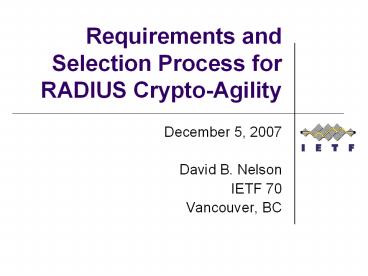Requirements%20and%20Selection%20Process%20for%20RADIUS%20Crypto-Agility - PowerPoint PPT Presentation
Title:
Requirements%20and%20Selection%20Process%20for%20RADIUS%20Crypto-Agility
Description:
Requirements (1/5) ... Requirements (3/5) Proposals need to avoid security compromise, even where the RADIUS shared secret ... – PowerPoint PPT presentation
Number of Views:12
Avg rating:3.0/5.0
Title: Requirements%20and%20Selection%20Process%20for%20RADIUS%20Crypto-Agility
1
Requirements and Selection Process for RADIUS
Crypto-Agility
- December 5, 2007
- David B. Nelson
- IETF 70
- Vancouver, BC
2
The Goals
- To develop one or more backward compatible,
interoperable mechanisms for the negotiation of
cryptographic algorithms within RADIUS. - To satisfy the mandate from the Security Area
Directorate for all IETF working groups to
evaluate the feasibility for adding
crypto-agility to existing IETF protocols, and
propose solutions where feasible.
3
Process Steps (1/2)
- Discuss and refine the requirements for a
solution to the problem, coming to consensus at
IETF 68 in Prague - DONE - Issue a call for document submissions meeting the
problem requirements, during IETF 68, requesting
documents be submitted for consideration within
30 days DONE - Authors to submit evaluation of proposals against
the requirements DONE - Address the Automated Key Management requirement
of RFC 4107, and discussion on the list from Sam
Hartman.
4
Process Steps (2/2)
- Discussion of the proposals at IETF 69 HH 70
and on the RADEXT WG mailing list. - If consensus emerges, adoption of the winning
proposal as a Standards Track WG work item. - If consensus does not emerge, acceptance of one
or more documents with substantial support as
Experimental Track WG work items. - Completion of work and submission of documents to
the IESG.
5
Requirements (1/5)
- Proposals are not restricted to utilizing
technology described in existing RFCs. - Proposals MUST support the negotiation of
cryptographic algorithms for per-packet
integrity/authentication protection. - Support for confidentiality of entire RADIUS
packets is OPTIONAL. - However, proposals MUST support the negotiation
of algorithms for encryption (sometimes referred
to as "hiding") of RADIUS attributes. - It is desirable for proposals to provide for the
encryption of existing attributes.
6
Requirements (2/5)
- Proposals MUST support replay protection.
Existing mechanisms for replay protection of
RADIUS messages are inadequate. - Crypto-agility solutions need to specify
mandatory-to-implement algorithms for each
mechanism. - Proposals need to demonstrate backward
compatibility with existing implementations. - A solution needs to be able to send packets that
a legacy RADIUS client or server will receive and
process successfully. - A solution needs to be capable of receiving and
processing packets from a legacy RADIUS client or
server.
7
Requirements (3/5)
- Proposals need to avoid security compromise, even
where the RADIUS shared secret is exposed. This
includes protection against bidding down attacks.
- Proposals need to cede change control to the
IETF. - Proposals need to be interoperable between
independent implementations based purely on the
information provided in the specification. - Proposals need to apply to all RADIUS packets.
- Proposals MUST include a Diameter compatibility
section.
8
Requirements (4/5)
- Proposals SHOULD NOT require fundamental changes
to the RADIUS operational model. - Addition of new capabilities to the RADIUS
protocol is out of scope a proposal should focus
on the crypto-agility problem and nothing else. - Proposals should not require new attribute
formats or include definition of new RADIUS
services. - RADEXT WG charter restriction against definition
of "new security mechanisms" should be
interpreted as prohibiting changes to the basic
RADIUS packet format (e.g. headers), but permits
new crypto-algorithms to be substituted for use
in existing security mechanisms.
9
Requirements (5/5) - new
- Proposals MUST address the requirements of RFC
4107 for Automated Key Management. - Is this the consensus of the WG?
- If this requirement would result in a blocking
DISCUSS in IESG review, do we want to go forward? - If we agree with this requirement, then all
submitted proposals need a write-up as to how
provide Automated Key Management.
10
Discussion points
- Sam Hartman (Security Area AD) wrote on the
RADEXT mailing list - I think that the applicability of RFC 4107 to
radius crypto agility - work is kind of complicated.
- I guess my main question is who is driving the
work, who will use it. - My personal opinion is that updating radius
crypto agility without - adding some form of automated key management
doesn't have a lot of - value and may not be worth doing.
- However if there are users and implementers who
see the value in doing - the crypto agility updates, then perhaps it makes
sense to do. - So, my question to you is what is driving this
work besides a desire - to be good security citizens?
11
Discussion points
- Follow up discussion on the RADEXT list
- Davidgt Well, besides that, some folks at Cisco
expressed a desire - Davidgt to replace the crypto elements of RADIUS
(e.g. key wrap, - Davidgt MAC, etc.) with algorithms and modes that
would allow - Davidgt systems including RADIUS to receive FIPS
certification, for - Davidgt solutions in government and financial
services markets. - Davidgt Additionally, the folks behind the EduRoam
consortium in - Davidgt Europe have deployed RADIUS over TLS for
inter-university - Davidgt roaming authentication.
- Sam I think automated key management is
important for both of these use cases.
12
Feedback?































